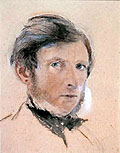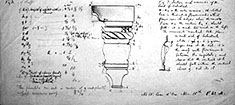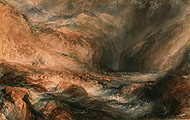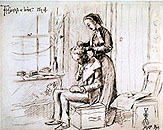| |
 |
|
|
One hundred years after the death of English critic
John Ruskin (1819-1900), New York's Morgan Library has staged an
exhibition that feels like a tabloid in a reliquary. With polite
ellipsis the sedate Morgan attempts to correlate Ruskin's perverse
emotional landscape with his grand views of palpable landscape,
architecture, and art. Here the visitor finds all the debris of
angst and bodies to be expected from a psycho-biographical dissection.
The carnage is contained on pages of cramped and lyrical writing
and in prison-like grids of words set at right angles to one another.
These artifacts are further secreted in glass vitrines and encased
in the hush of the Morgan, an institution that retains in the 21st
century a feeling of dim, tearoom propriety. Within the exhibition,
a strange mechanical whir made itself felt near one vitrine, and
a visitor jumped away in fear that she was being chastised publicly
for leaning on the glass. The noise, however, emanated from deeper
within the walls, climate control or ventilation. Still, a spirit
of repression and the threat of a public slap on the wrist seem
apt if unintended companions for this tour of Ruskin's aesthetic
manifestos and misaimed arrows of love.
John Ruskin was the pre-eminent figure in Victorian
art criticism. He helped initiate the Gothic Revival movement in
architecture and championed the literature and art of the otherwise
disparaged Pre-Raphaelites. Ruskin's prescient admiration of British
landscape painter J.M.W. Turner was so immense that it inspired
a caricature of the critic trumpeting from two horns his own glory
and that of the ur-Impressionist. Long-lived and enormously prolific,
Ruskin produced tracts on social issues, literary essays and art
reviews along with 39 full-length works. These included The Seven
Lamps of Architecture and The Stones of Venice. A few
of his sketches and meticulous drawings for the latter volume were
on view at the Morgan. Ruskin's evangelical voice profoundly influenced
a century's direction of writing on art and architecture. Today,
however, his critical presence has dissolved to a Turner-esque haze.
 |
|
|
By providing material evidence of Ruskin's life
Morgan curator Robert Parks attempted to suggest a resurrected Ruskin.
With deceptive candor, the Library draws exclusively upon its seemingly
limitless archival reserves to chronicle Ruskin's critical output,
the peculiarly Victorian circumstances of his scandalous marriage
and his questionable affection for young girls. These archives include
the Bowerswell Papers, encompassing letters and other material from
the families of his former wife and her second husband, the Pre-Raphaelite
artist John Everett Millais (1829-1896). To animate his revived
subject Parks also includes Ruskin's childhood mineral collection,
teen-age sermons, self-portrait and, of course, his own letters
and those of his family, friends and colleagues among the displayed
items.
Rather than the Italy and England of the exhibition's
title, the true compass points of the Morgan's topography are Ruskin's
aesthetic genius and his cold-blooded yet passionate assessment
of contemporary England and Italy. Grafted onto these points is
the critic's personal trajectory, from cosseted wunderkind to emotionally
sadistic husband to frenzied admirer of frocked little girls. As
the Morgan notes, Ruskin's marriage of six years was publicly annulled
for non-consummation; his ex-wife quickly rebounded with a marriage
to Millais. That artist's intimate drawing of Mrs. Ruskin cutting
his hair (The Countess as Barber, 1853) offers the only view
of a domestic interior in the Morgan exhibition. This sweet domesticity
opposes the public and exterior nature of Ruskin's political and
architectural pre-occupations, his forums and facades.
In fact, it is interesting to consider Ruskin's
life from the point of view of architecture, both interior and exterior.
The frontages of buildings, their exteriority, served for Ruskin
as sources of spiritual allegory. In this way, architecture shared
characteristics with the nature depicted in Turner's paintings.
Both were expressive and spiritual. The Morgan goes further, making
a metaphor of the exteriority of visual enterprise. The exhibition
suggests that Ruskin's public persona offered a facade of reasoned
and harmonious thought. Yet, public scandal over his annulled marriage
and documentation of his perverse interest in young girls betray
interior disorder under this scaffold of erudition. Similarly, although
his family presented an exterior of prosperous conventionality,
internally they presented a white-knuckled grasp of Arcadia. This
is first seen in his parents' consanguinity: they were first cousins.
It continued with their claustrophobic exclusion of outsiders which
was most clearly expressed in their lack of sympathy for their daughter-in-law.
Despite their distrust of outsiders, the young Ruskin
was allowed to travel. He began a lifetime of travels to Italy at
13 in 1833. His wine-merchant father had business there, and his
Bible-imbibing mother seized upon Italy as a worthy holiday destination.1
The contrast of an increasingly industrialized and gritty England
to the light-saturated splendor of the Italian buildings profoundly
influenced his ideas on industrialization and architecture. Thus,
the architecture of Italy played a major role in his life.
 |
|
|
Architecture, in general, also played an idiosyncratic
role in his personal history. Before John Ruskin's birth, his maternal
grandfather had committed suicide at home, probably by slitting
his throat. Two generations later, when Ruskin wanted to marry Euphemia
("Effie") Chalmers Gray, one of his mother's objections
to the match was that the proposed bride had grown up in this grandfather's
house. For Mrs. Ruskin, the hapless Effie was a walking memento
mori. The young woman's childhood house--built architecture--blurred
into a sad facet of personality.
Of course, much of Ruskin's renown rightfully stemmed
from his persuasive arguments on art and architecture. Mixing exterior
and interior, he brought "the story of his own life" to
this august commentary, lacing it with "his upbringing, religious
doubts, emotional attachments, and bouts of madness."2
The Morgan notes that the 1849 publication of The Seven Lamps
of Architecture established Ruskin as "a central figure
in the Gothic Revival movement." He persuasively argued that
when measured against the expressiveness of Gothic architecture
contemporary English buildings appeared dolefully deficient. Ruskin
lamented that: "All that we do is small and mean...thin, and
wasted, and unsubstantial." By contrast, each ornament and
detail of Gothic architecture contained an allegory of nationalism
and identification.
Excerpts of Ruskin's steely criticism are matched
by implication with evidence of his coldness toward his wife in
the Morgan's psychologically informed approach. "Ruskin's Italy,
Ruskin's England" suggests that the Magi-like adoration by
his parents, well into his adulthood, caused Ruskin's arrested development
and doomed him sexually. For example, he never consummated this
marriage to Effie.
 |
|
|
However, some years after his failed marriage to
Effie, Ruskin formed a fondness for his 10-year-old student, Rose
La Touche. Tellingly, he described her naïve charms as "ineffable".
After ten years of infatuation, the forty-nine-year-old Ruskin horrified
the pious and sickly Rose with a declaration of his passion for
her. She refused his proposal of marriage and died not long after,
plunging her desperate suitor into an irremediable decline. An inconsolable
Ruskin incorporated roses into colophons for a series of 96 "Letters
to the Workmen and Labourers of England," peculiarly mixing
tracts on social reform with the most private form of sentiment.3
The Morgan's psycho-biographical approach shadows
Ruskin's own critical work. These writings documented and were informed
by his personal reactions to landscape and to art. George P. Landow,
Brown University Professor of Art History and English, has noted
that in including "his own experience" when re-creating
a work of art in words, Ruskin was "like the evangelical preacher
and the romantic poet,"4 both staples of the Victorian era.
Landow observes that Ruskin applied the syntax of sermons to form
an evangelical template for art criticism. The critic used the hortatory
conviction of the evangelical to promote the spiritually expressive
power of the art and architecture he admired.
The Morgan does not take to the pulpit but rather
indirectly speaks of Ruskin's improprieties and perversions in its
efforts to redirect attention to Ruskin's greatness as a critic
of art and architecture and as a social reformer. In his recent
biography, John Ruskin: The Later Years, Tim Hilton suggests
more explicitly that the critic actively pursued social discourse
with young girls.5 In her New York Times review of his book,
Valentine Cunningham calls Hilton's revelations "an arresting
record of Ruskin's crippling obsession with little girls -- at schools
he endowed, in London parks, by the Italian wayside, in the studio
of the illustrator Kate Greenaway (he made up to her little models
with gifts of skipping ropes and magnetic fish)."6
In his "mentoring" of Greenaway, the renowned
critic urged her to produce for him versions of her cottage-y little
girls with, as the Morgan text puts it, "less clothing."
In one of a number of unselfconsciously perverse letters to Greenaway,
Ruskin wrote of a young model: "Draw her for me without her
hat...and, without her shoes." It is possible that details
such as these were not substantiated in documents owned by the Morgan,
and for this reason do not surface in its exhibition.
In the end, it does not seem that the Morgan has
attempted to hush up the dark side of John Ruskin so much as to
pay homage to the forces that made him what he was. Ruskin's ability
to train his eye on a landscape or a stone ornament or to be transfixed
by a little girl spoke to a singularity of purpose and a complexity
of vision emblematic of the Victorian age. While its title suggests
directionality, "Ruskin's Italy, Ruskin's England," is
all about indirection, about sunlight and shadow, and that seems
in every way correct.
Notes>>
Author's Bio>>
|
|